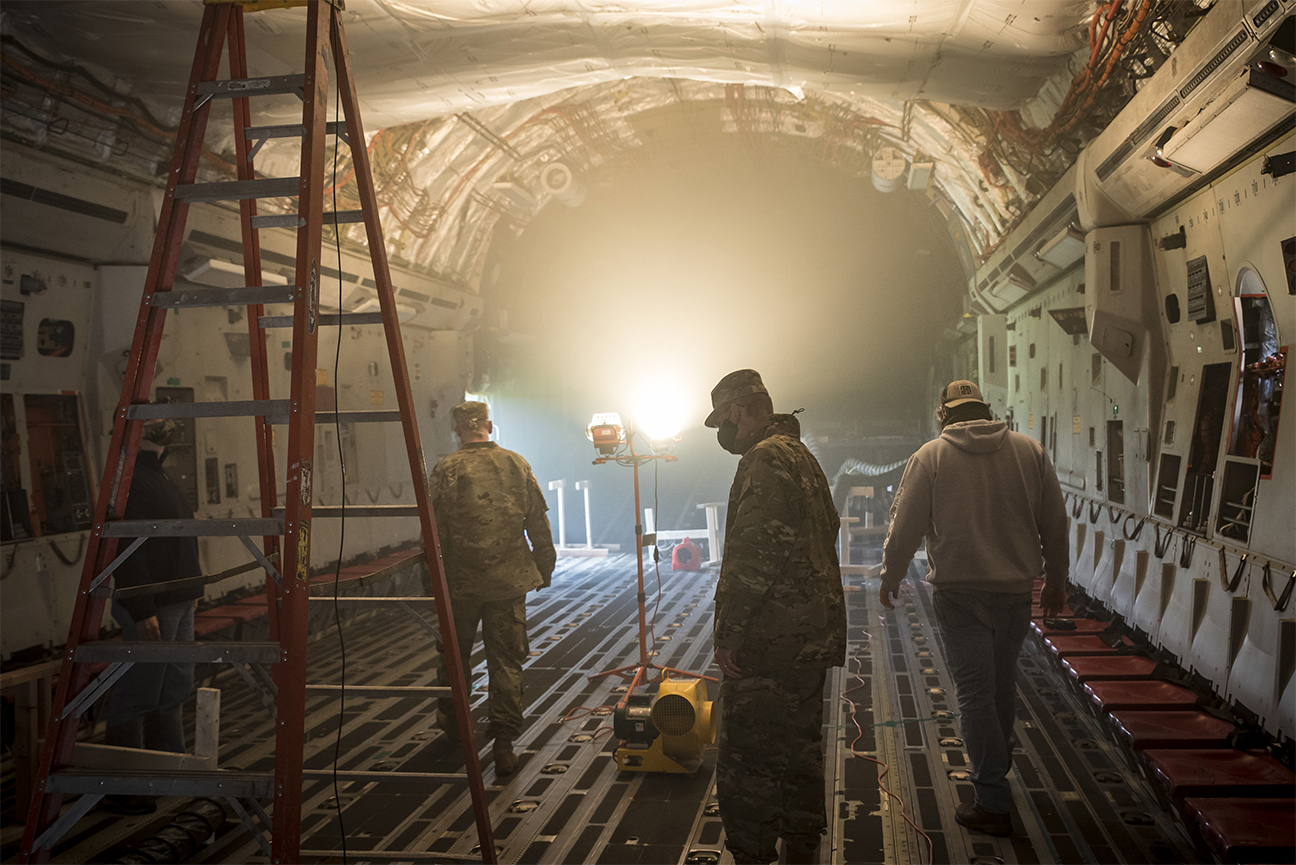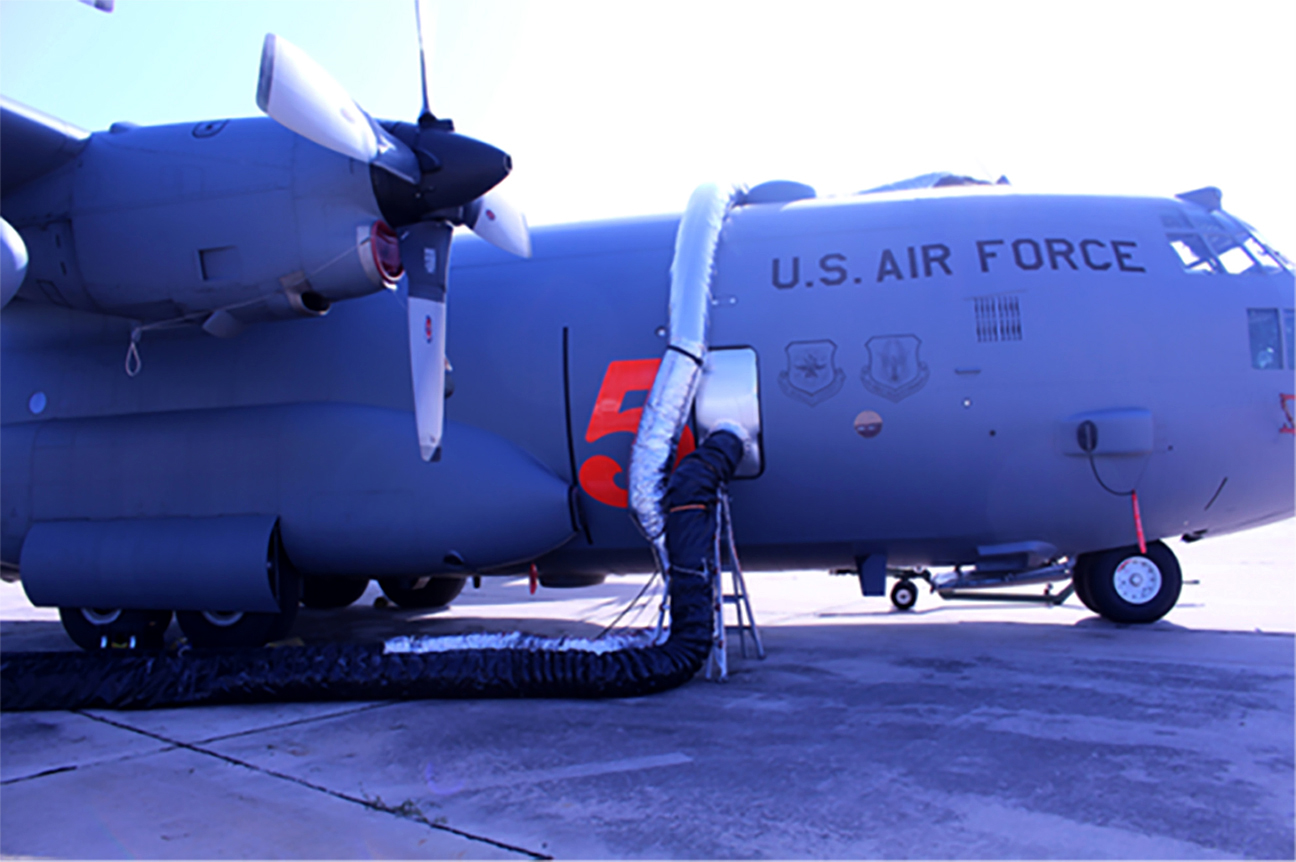AIRCRAFT DECONTAMINATION
What is AFRL doing to protect Airmen from COVID-19?
To ensure the health and safety of Airmen amid the pandemic, a team from the Air Force Research Laboratory evaluated various aircraft decontamination methods and identified the use of heat as the most promising technique. Since the coronavirus spreads easily and may remain viable on surfaces for days under certain conditions, transporting infected patients aboard aircraft places aircrews and passengers at risk for potential exposure. Aircraft interiors must be decontaminated quickly and efficiently to support future patient transfer missions in a clean and safe environment.
With more than a decade of relevant research, AFRL’s team of bioenvironmental, aircraft materials and medical experts released a document to government agencies and their contractors providing information on aircraft materials-compatible decontamination methods for emerging diseases, specifically COVID-19, caused by the novel coronavirus. This guidance also covers the approved methods of aircraft decontamination. Drafted by various AFRL subject matter experts and based on existing Air Force technical orders and literature, this information has become the basis for rapid decisions from the Air Force Life Cycle Management Center to Logistics Centers and operational units across the service.
What is AFRL doing to support the Air Force amid the pandemic?
AFRL experts are participating in a Joint Urgent Operational Need team that delivers recommendations on suitable decontamination methods. Selecting an appropriate method, one that reduces contaminants while preventing corrosion, degradation and other system failures, is key to saving lives and ensuring mission readiness. Comprised of experts from AFLCMC, AFRL and the Air Mobility Command, the COVID Rapid Action Decontamination team is also streamlining questions and answers from the Air Force community.
Ground Heater Disinfection
AFRL is working with Battelle, an Ohio based firm, to evaluate the effectiveness of heat against the novel coronavirus. In May 2020, researchers from the AFRL 711th Human Performance Wing conducted tests using common ground heaters to raise the interior temperature of a C-17 aircraft to 120 degrees Fahrenheit. In a separate test, Battelle’s data indicated that under certain conditions the temperatures reached during the trials were sufficient to disable the virus to safe levels on surfaces materials including aluminum, silicon and nylon webbing.

Air Force Research Laboratory team members look over a C-17 used to investigate the ability of ground heaters to raise interiors to temperatures sufficient to kill the COVID-19 virus. Photo Credit: U.S. Air Force photo/Richard Eldridge
Since 2010, AFRL has expanded its in-house expertise and developed solutions in partnership with the rest of the Air Force. Heat disinfection is only one approach AFRL and partner organizations are looking into to assist in COVID-19 flight safety. Researchers are assessing various solutions including chemicals, common soaps and household cleaning items, ultraviolet light, ionization, and simply “airing out” aircraft between missions. Many of these potential solutions could be employed alone or together to achieve the desired results. Going forward, AFRL will continue to develop and demonstrate capabilities that disinfect military assets utilizing commonly available equipment and materials. The ultimate goal is to prove the efficacy of a process for quick and easy replication throughout the Air Force.
Joint Biological Agent Decontamination System
The Joint Biological Agent Decontamination System (JBADS) employs a revolutionary decontamination process that expedites the return of contaminated aircraft to full service without placing aircrew members and support personnel at risk of exposure. Developed by AFRL, in conjunction with the Joint Program Executive Office for Chemical and Biological Defense (JPEO-CBD) and the Defense Threat Reduction Agency (DTRA), as part of a collaborative multi-year project, this system uses an integrated heat and humidity generating system to raise the temperature and disinfect areas on an aircraft’s interior and exterior that may harbor hazardous microbes. JBADS uses high temperatures of 140 to 180 degrees Fahrenheit and controlled humidity levels to eliminate contaminants in an enclosed environment without harming aircraft systems. The system enables full decontamination of an entire aircraft.
While the JBADS team optimized the system to eliminate the COVID-19 threat, the process requires highly-specialized equipment, which is not widely-available. Therefore, JBADS cannot serve as a go-to solution for immediate usage across the entire military aviation community. Conversely, ground heaters are common and widely available.
Multiple demonstrations have proved JBADS as safe, environmentally friendly and effective against multiple agents. In 2015, this process neutralized select biological warfare agents in the laboratory and killed numerous types of organisms that may pose a threat. Several Department of Defense and other government organizations contributed to development and testing including OSD’s Rapid Fielding Office, Department of Homeland Security, U.S. Navy, JPEO-CBD, DTRA, the U.S. Transportation Command, U.S. Strategic Command and Air Mobility Command.

Decontamination using the Joint Biological Agent Decontamination System on a C-130 airplane interior is performed in July 2016 to extinguish mold. (Photos courtesy of Dr. Wendy Goodson, AFRL)
